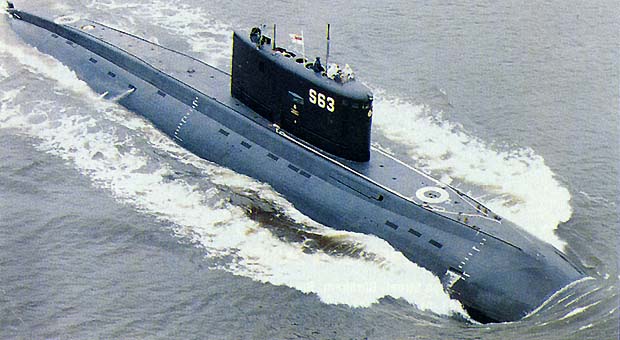

The Typhoon Class of SSBN is the largest submarine ever built (172m). They began commissioning in 1983. Constructed with five inner hulls inside a superstructure of two parallel main hulls. Design includes feature to travel under ice and for ice-breaking. This includes retractable hydroplanes and masts. Maximum diving depth is 400m. Speed is 12 knots when surfaced and 25 knots when submerged. Complement is 160. Typhoon is capable of spending 120 days at sea.
Missiles The submarine carries 20 ICBM's forward of the sail. Each missile consists of 10 independently targetable MIRV's, each with a 100 kiloton nuclear warhead. Range is 8,300 km with an accuracy of 500 m.
Torpedoes Typhoon has a total of six forward torpedo tubes that can launch various munitions. She carries a total of 22 antisubmarine missiles and torpedoes of varying types.
Sonar The sonar is an active/passive search and attack type.
Masts The submarine is fitted with I/J band surface target detection radar. Countermeasures include ESM, radar warning system and direction-finding system. Two floating antenna buoys for radio, target designation, and satellite navigation. Two optical periscopes for the commander and one for general use.
Summary The Typhoon Class SSBN is designed as a first-strike weapon. Having the ability to submerge for long periods of time and the capability to deliver a large number of missiles make her a viable treat to U.S. security. This platform also serves as a deterrent, since she could deliver a very potent second strike in retaliation. Her operational parameters usually include slow subsurface operations close to Soviet soil. U.S. counters to this treat are ASW aircraft and surface craft, subsurface tracking with our SSN's and submerged arrays, magnetic detection and tracking, etc. The large size and strategic importance of this craft does not lend itself to a subsurface attack stance. The large payload of it's weapons is standard for soviet weapons, opting for size over accuracy in targeting.
Kilo Class (SSK)

The Kilo Class of diesel-electric fast attack submarines began commissioning in 1983. The submarine consists of six watertight compartments in a pressurized double-hull. This design and good reserve bouyance lead to increased survivability if the submarine is holed. The Type 636 incorporates an air-independent propulsion (AIP) system. The Type 636 submarine is considered to be one of the quietest diesel submararines in the world. It is capable of detecting an enemy submarine at a range of 3 to 4 times greater than can be detected itself. The low noise level of the submarine has been achieved with with selection of quiet machinery, vibration and noise isolation and a special anti-acoustic rubber coating applied on the outer hull surface. Maximum diving depth is 300m. Speed is 11 knots when surfaced and 20 knots when submerged. Complement is 52. Typhoon is capable of spending 45 days at sea.
Torpedoes Kilo has a total of six 533 mm forward torpedo tubes that can launch various munitions. She carries a total of 18 torpedoes or 24 mines. Two torpedo tubes are designed for firing remote-controlled torpedoes with a very high accuracy. The computer-controlled torpedo system is provided with a quick-loading device. It takes only 15 seconds to prepare stand-by torpedo tubes for firing. The first salvo is fired within two minutes and the second within 5 minutes.
Sonar The sonar is an active/passive
search and attack type providing the following:
1. detection of submarine and surface ships in listening
mode.
2. echo-ranging in a +/-30 degrees sector of the target relative bearing.
3. telephone and telegraph communication in both long and short range modes.
4. detection of underwater sound signals and determination of the signal
bearing.
Masts The submarine is fitted with I/J band surface target detection radar. Countermeasures include ESM, radar warning system and direction-finding system. Two floating antenna buoys for radio, target designation, and satellite navigation. Two optical periscopes for the commander and one for air defense use.
Summary The Kilo Class SSK is designed as a multi-purpose attack weapon. Her operational parameters usually include anti-submarine (ASW) and anti-surface ship (ASuW) warfare in the protection of naval bases, coastal installations, sea lanes, and general reconnaissance and patrol missions. . The 636's low detectability and rapid-action torpedoes makes this submarine a deadly foe. U.S. counters to this treat are ASW aircraft and surface craft, subsurface tracking with our SSN's and submerged arrays, magnetic detection and tracking, etc. The Kilo being smaller than the Typhoon SSBN provides for a smaller contact with much greater reaction time in a defensive mode. One of its drawbacks is that it is diesel powered. This limits submerged operations to 400 miles and allows for easier detection and targeting when snokeling. A successor which incorporates an air-independent propulsion (AIP) system is being developed. The AIP system could also be available for retrofit to the other versions. This would allow submerged diesel propulsion providing long-range submerged operations.